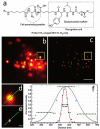Fluorescent Probes for Super-Resolution Microscopy of Lysosomes
- PMID: 33134657
- PMCID: PMC7593992
- DOI: 10.1021/acsomega.0c04018
Fluorescent Probes for Super-Resolution Microscopy of Lysosomes
Abstract
Lysosomes are membrane-enclosed small spherical cytoplasmic organelles. Malfunctioning and abnormalities in lysosomes can cause a plethora of neurodegenerative diseases. Consequently, understanding the structural information on lysosomes down to a subnanometer level is essential. Recently, super-resolution imaging techniques enable us to visualize dynamical processes occurring in suborganelle structures inside living cells down to subnanometer accuracy by breaking the diffraction limit. A brighter and highly photostable fluorescent probe is essential for super-resolution microscopy. In this regard, this mini-review deals with the various types of super-resolution techniques and the probes that are used to specifically stain and resolve the structure of the lysosomes.
© 2020 American Chemical Society.
Conflict of interest statement
The authors declare no competing financial interest.
Figures












References
Publication types
LinkOut - more resources
Full Text Sources

